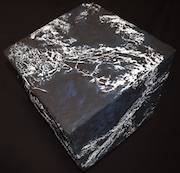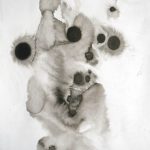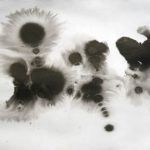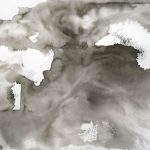Interview by Thomas Wacker on 13 August 1997
1. Please give me some information about yourself. My, that’s a bit general, isn’t it? Well, I’ll give you the mundane stuff, I guess. I’m turning 34 years old next week. I was born in the San Francisco Bay Area, in the region that’s now refered to as Silicon Valley. I studied pscychology at Stanford University, and I still live here, in a small suburban home with two cats and my companion of 9 years, Dixie.
2. When did you start playing music and what’s your intention and philosophy behind this creativity?
I first started playing my own music by improvising on my parent’s piano at about age 12. I started building a modular analog synthesizer when I was around 13 or 14. I had discovered “spacemusic” and I wanted to create my own. This was around the same time that groups like Throbbing Gristle, Cabaret Voltaire, Pere Ubu and TuxedoMoon were getting started, and they had a big influence on my direction. In 1979 I started a group with Rick Davies (who is now my partner in Amoeba) and a bassist named John Spencer, playing very strange improvised electronic noise. I was in a few other groups after that, but began pursuing my solo career so I could concentrate more on focused, slow motion soundscapes. This is when my musical philosophies came into sharper focus. I decided that I wanted to create music that was completely psychoactive, like a sonic hallucinogen, which could immerse the listener into a kind of aural womb. While I have since moved on to integrate more rhythmic and melodic/harmonic structure into my music, I think that original idea of the sonic hallucinogen still permeates most of what I do.
3. How would you describe your kind of music in your own words? Do you think it could be described as Dark Ambient?
It’s hard for me to feel comfortable with a single term for what I do, since my albums cover a pretty wide range. “Dark Ambient” might apply to albums like Trances/Drones, Stalker or A Troubled Resting Place, but not to Propagation, Gaudi or Geometry. I don’t even think my “dark” albums are particularly forboding. When Brian Williams and I recorded Stalker, we felt we were creating something mysterious and strange, but not particularly dark. I think when people set out to create something dark it just comes off like some B-grade horror movie. I am far more interested in exploring the mysteries of sound, where concepts of dark and light become irrelevant. I want the music to operate on a level that integrates a wide range of human experience, emotion, and ecstacy. I’ve tried various words for what I do, but none of them feel quite right: Trance Music, Soundscapes, Head Music… if you can think of a name that works, let me know!
4. You’ve collaborate with a lot of similar artists from the USA in the past – like STEVE ROACH for example. There are a lot more of those artists in the United States… MUSLIMGAUZE, MICHAEL STEARNS or others… more than elsewhere on this world. Do you think that there must be a reason for this?
I’ve also collaborated with Lustmord, who is from Wales, Alio Die from Italy, and Vidna Obmana from Belgium. Rick Davies – the other half of Amoeba – grew up in Spain and England. I don’t think there is anything unique about the USA that generates a specific musical style. In fact, the musical territory that I inhabit seems to have fewer national boundaries than most. There is no language barrier in instrumental music (Amoeba is an exception); furthermore, most of us are integrating the musical languages of many cultures into our own style. If there is anything about this approach which is characteristically American, perhaps it comes from the fact that we have no real cultural roots, so we must borrow from other traditions, or create our own from scratch. Perhaps Americans feel more need for an archaic source because our culture is multi-ethnic and in constant transition. Overall, however, I don’t think this is specifically an American musical form.
5. Do you know the music of DANIEL MENCHE and if yes, what do you think about his kind of work?
I’ve heard his name, but I have never heard his music. Sorry.
6. What can you tell me about the concept of your concerts for sleeping audiences?
The Sleep Concerts grew out of several converging interests. At a sonic level, I was expermenting with a technique I called self-determinate synthesis, where I tried to create patches on my modular synth with complex constrained randomness built in. I would leave the synth playing itself for days at a time, listening to the constant subtle random variations. I began to appreciate these extended quasi-musical structures, in part because of their trance inducing qualities. I tried to think of ways to introduce others to this slow-motion music, trying to circumvent the normal audience expectations at a concert. Inviting them to sleep seemed the most obvious way to change their approach to listening. This idea coincided nicely with my fascination with altered states of consciousness, trance and dreaming. It occured to me that I could structure the slow music so that it could stimulate an awareness of internal states during the night, especially dreams and hypnogic imagery. So at a sensory level, Sleep Concerts are a pure exploration in sound immersion, while at a psychological level, they provide an environment for exploring conscious states and internal imagery.
I want the listeners to discover the region between sleep and waking, the hypnogogic state, where thinking is visual and non-linear, where the slow sound textures can merge with dreams and create an altered state of consciousness. I try to undermine people’s listening expectations, so they can be open to very slow changes, so they can become more sensitive to the power of their sonic environment. I try to transform the typical concert experience into a trance ritual.
7. You started very young to build your own synthsizers… when you were 13 years old. Did you get some lessons in other instruments before and why did you choose to experiment with electronic music?
I guess I grew up around music and electronics – my father is a jazz guitarist and an electronic engineer. When I was about 10 I took viola lessons for six weeks, and I sang in choirs occasionally. I didn’t pursue either because the music didn’t interest me. As I began to develop my musical tastes, I gravitated towards keyboards, and started improvising on my parents piano. I really wanted to play electronic music because that was what I was listening to. Since I couldn’t afford to buy any synthesizers, I had to build them. Simple as that!
8. Where do you see your own musical roots?
I’m not sure if I have any one source. I don’t have any formal training in the “Western” musical tradition. I suppose I’ve just integrated the hodgepodge of musical sounds that I grew up with, ranging from jazz and modern classical, minimalism, experimental electronic, psychedelic, European spacemusic, pop and early industrial, with a dose of Javanese, Indian and North African music.
9. What can you tell me about your musical influences and inspirations?
I guess the answer would be about the same as above.
10. You worked out a form of analysis for sleep and dream investigation and got some studies in psychology. Can you please tell me why are you so interested in those themes/topics?
I’m interested in all areas of mental exploration, with a primary interest in any experiences that potentiate ecstacy and epiphany. Basically I am interested in understanding (and experiencing) as much as possible of the range of the human psyche, and I feel that this interior realm is the least understood in our culture. My academic studies focused both on perceptual psycholgy and the psychophysiology of consciousness. I ended up working with Dr. Stephen LaBerge at Stanford, studying Lucid Dreaming. I helped him develop a device that senses when a person is in REM sleep, and signals them in their sleep to tell them they are dreaming. We started a company called The Lucidity Institute to market a family of these devices. If anyone is interested they can call 1-800-GO LUCID in the USA or check their website at www.lucidity.com.
11. One of my personal favorites of ROBERT RICH is the 3″ CD Night Sky Replies from the Italian label Amplexus. But I think these tracks are released on another CD of yours too. Can you please tell me what do you like to express with these tracks?
Night Sky Replies reappears on A Troubled Resting Place (Fathom), along with other abstract pieces recorded for compilations and limited editions. Those pieces marked a new excursion for me into a completely surreal sound world, and their titles are meant to evoke abstract and nonlinear connections. It’s really not about anything other than a pure internal experience, a gestalt. Those pieces also sustain a balance between stasis and tension, which is described in the title A Troubled Resting Place. I have completed a sequel to this album, Below Zero, which carries these ideas further into an even more abstract sound territory. Some of the pieces on Below Zero will be released on compilations next year, some are already out (such as “Starmaker” on the Manifold collection, Narratives:Works of Fiction.) Hopefully Below Zero itself will come out in late 1998.
12. Do you have any plans for your musical future?
I have plans for the next two years or so, regarding the next projects that I hope to work on. Beyond that I will wait to see where my interests lead me. I am currently finishing my next solo album, Flux, to be released on Fathom in Feb ’98. Then I hope to start a new Amoeba album with Rick Davies. Late ’98 should see the release of Below Zero and a re-release of a 1985 live concert called Inner Landscapes. I do have another solo album mapped out after that, but it’s too far in the future to discuss right now. Thank you.






You must be logged in to post a comment.